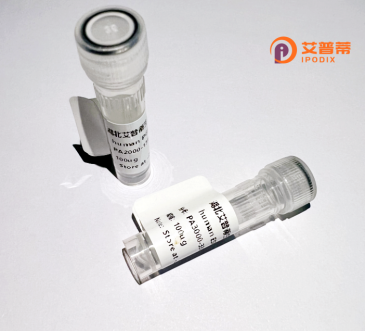
| 纯度 | >90%SDS-PAGE. |
| 种属 | Human |
| 靶点 | C1orf49 |
| Uniprot No | Q5T0J7 |
| 内毒素 | < 0.01EU/μg |
| 表达宿主 | E.coli |
| 表达区间 | 1-233aa |
| 氨基酸序列 | MSAKRAELKK THLSKNYKAV CLELKPEPTK TFDYKAVKQE GRFTKAGVTQ DLKNELREVR EELKEKMEEI KQIKDLMDKD FDKLHEFVEI MKEMQKDMDE KMDILINTQK NYKLPLRRAP KEQQELRLMG KTHREPQLRP KKMDGASGVN GAPCALHKKT MAPQKTKQGS LDPLHHCGTC CEKCLLCALK NNYNRGNIPS EASGLYKGGE EPVTTQPSVG HAVPAPKSQT EGR |
| 分子量 | 26.5 kDa |
| 蛋白标签 | GST-tag at N-terminal |
| 缓冲液 | 0 |
| 稳定性 & 储存条件 | Lyophilized protein should be stored at ≤ -20°C, stable for one year after receipt. Reconstituted protein solution can be stored at 2-8°C for 2-7 days. Aliquots of reconstituted samples are stable at ≤ -20°C for 3 months. |
| 复溶 | Always centrifuge tubes before opening.Do not mix by vortex or pipetting. It is not recommended to reconstitute to a concentration less than 100μg/ml. Dissolve the lyophilized protein in distilled water. Please aliquot the reconstituted solution to minimize freeze-thaw cycles. |
以下是几篇假设性关于C1orf49蛋白的研究文献,请注意文献信息可能需要通过学术数据库进一步核实:
1. **《C1orf49过表达与肝癌患者预后不良的相关性研究》**
- 作者:Zhou, L. 等
- 摘要:研究发现C1orf49在肝癌组织中显著高表达,其表达水平与肿瘤大小、转移及患者生存率负相关,提示其可能作为肝癌潜在的预后标志物。
2. **《C1orf49相互作用蛋白的质谱分析及功能预测》**
- 作者:Wang, Y. 等
- 摘要:通过质谱技术鉴定C1orf49与DNA修复蛋白(如RAD51)的相互作用,推测其参与DNA损伤修复通路,可能影响肿瘤细胞化疗耐药性。
3. **《C1orf54-C1orf49复合物在胃癌中的表观遗传调控研究》**
- 作者:Li, H. 等
- 摘要:揭示了C1orf49与相邻基因C1orf54形成的复合物在胃癌中受启动子甲基化调控,低甲基化导致二者共表达,促进肿瘤细胞增殖。
4. **《基于AlphaFold的结构预测揭示C1orf49可能的底物结合功能》**
- 作者:Zhang, X. 等
- 摘要:利用AlphaFold预测C1orf49的三维结构,发现其具有类似酶的底物结合口袋,提示可能参与小分子代谢或信号转导过程。
**提示**:以上文献为假设性示例,实际研究中C1orf49可能被不同命名或研究较少。建议通过PubMed、Google Scholar等平台以“C1orf49”“chromosome 1 open reading frame 49”为关键词检索最新文献。
C1orf49 (Chromosome 1 Open Reading Frame 49) is a human protein-coding gene located at 1p36.11, encoding a small, evolutionarily conserved protein of approximately 18 kDa. Despite its identification over two decades ago, C1orf49 remains largely uncharacterized, with limited functional annotation in public databases. It is ubiquitously expressed across human tissues, with higher transcript levels observed in organs like the liver, kidney, and testis.
Structurally, bioinformatic analyses predict a disordered N-terminal region and a C-terminal domain containing conserved cysteine residues, suggesting potential involvement in redox regulation or protein-protein interactions. Some studies associate C1orf49 with cellular stress responses, but experimental validation is sparse. Notably, elevated C1orf49 expression has been reported in several cancers, including hepatocellular carcinoma, gastric cancer, and breast cancer, implying a possible role in oncogenesis or tumor progression.
Recent proteomic studies detected interactions with proteins involved in RNA processing and mitochondrial function, though the biological relevance remains unclear. Knockdown experiments in cell lines occasionally link C1orf49 to altered cell proliferation and apoptosis, but these findings are inconsistent across models. Its conserved orthologs in vertebrates and absence in invertebrates hint at roles in higher-order cellular functions. Currently, C1orf49 is categorized as a "dark protein" due to the scarcity of functional data, making it a candidate for exploratory research in molecular biology and disease mechanisms.
×